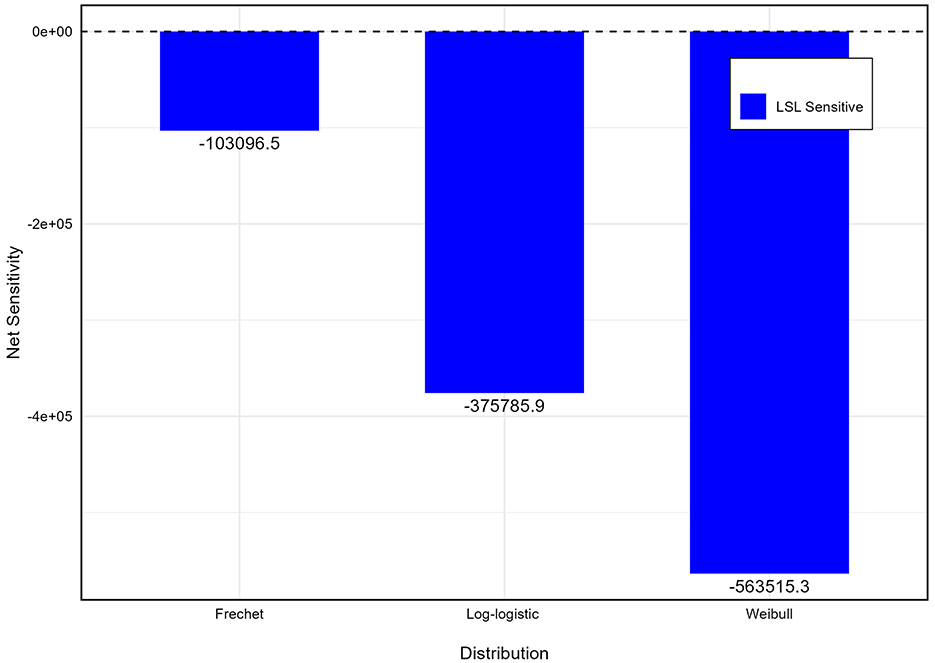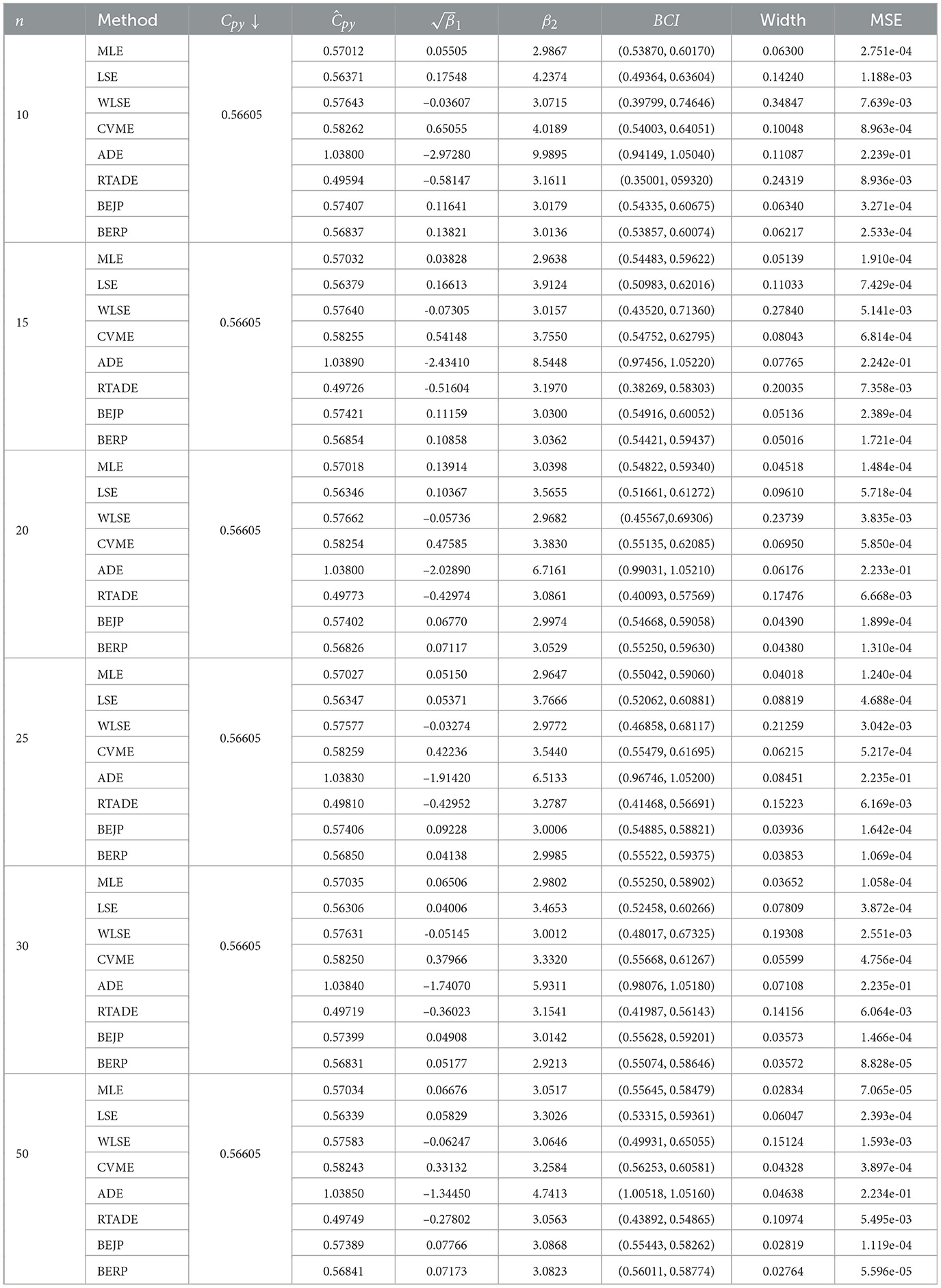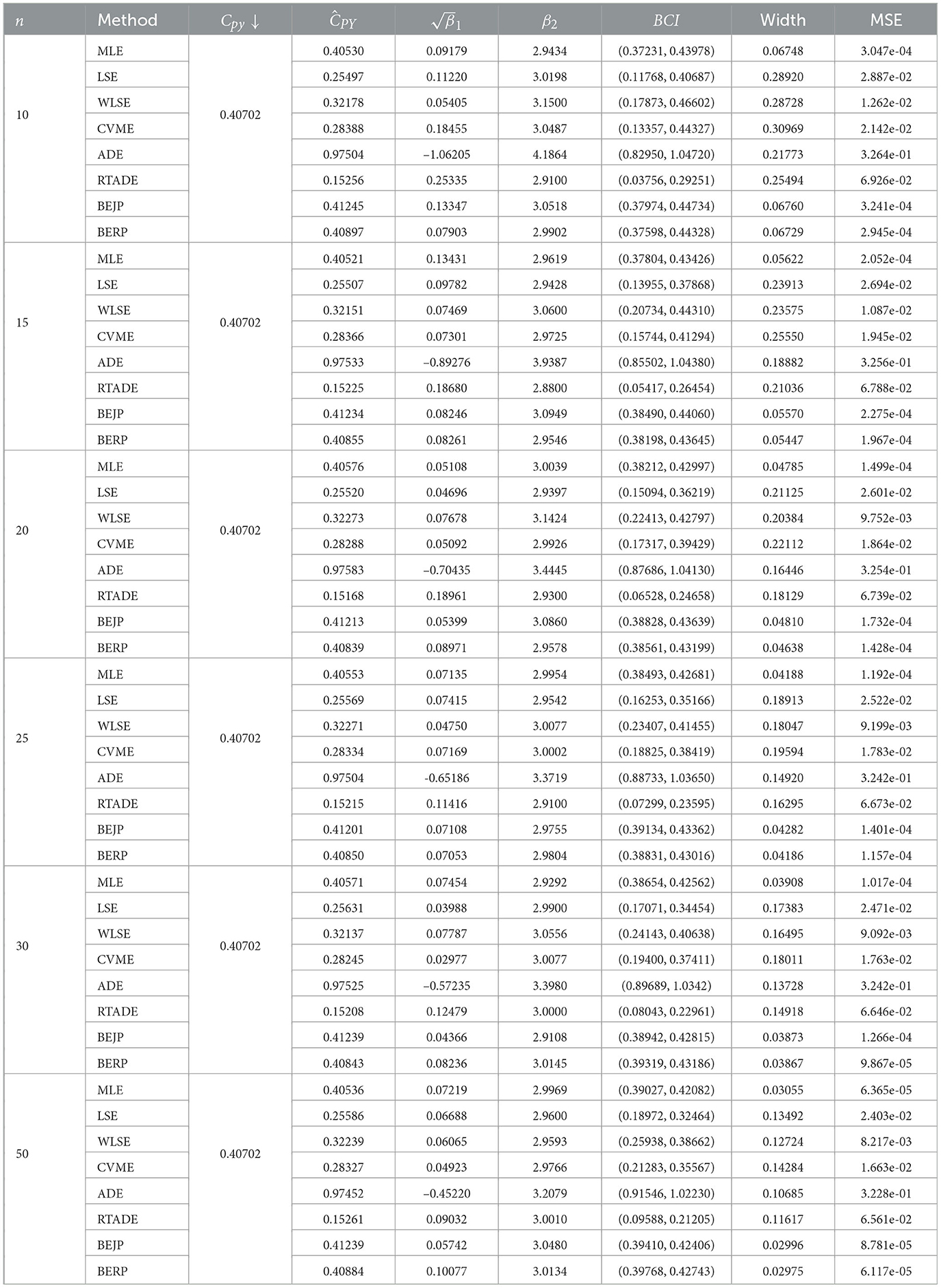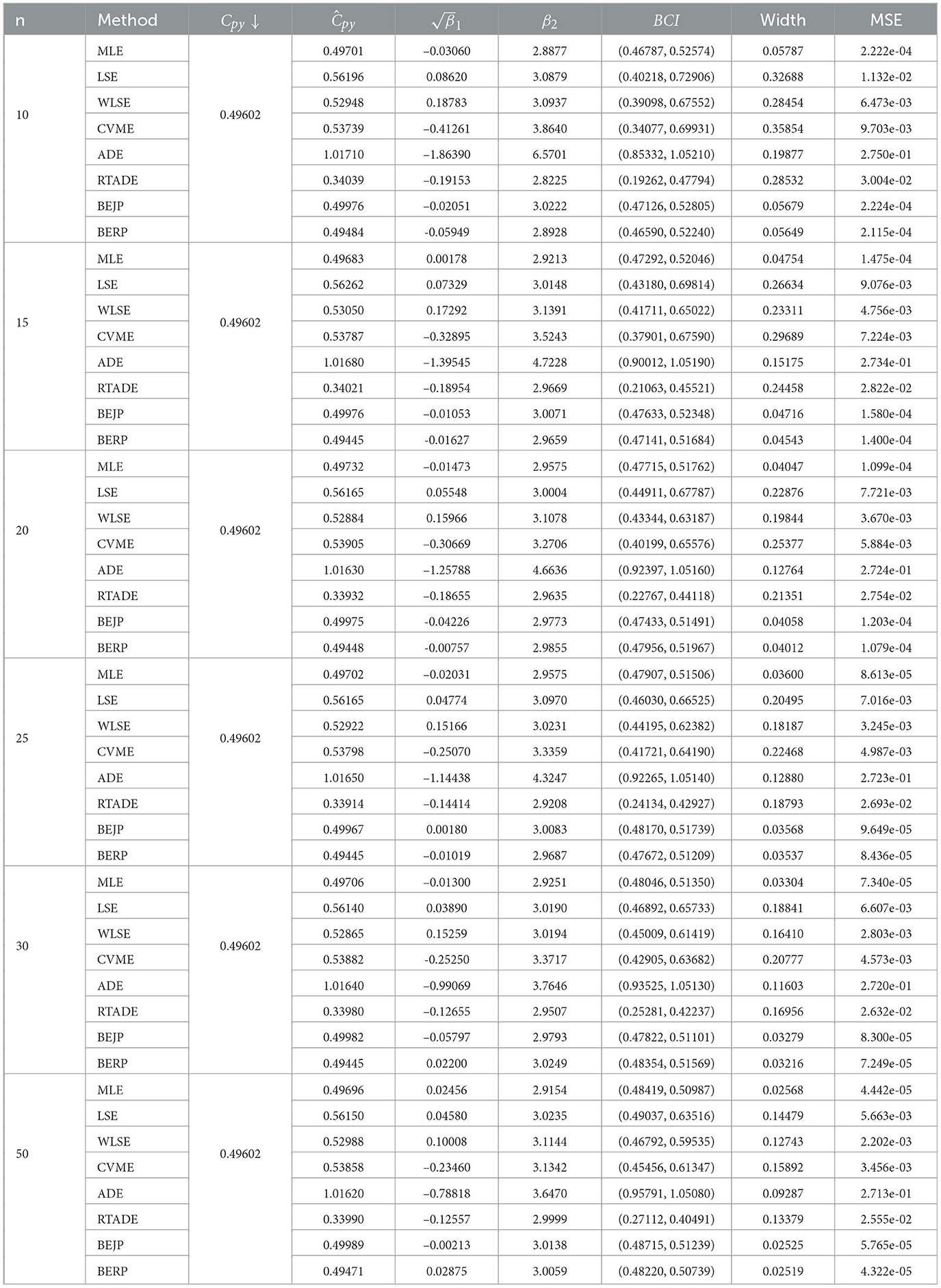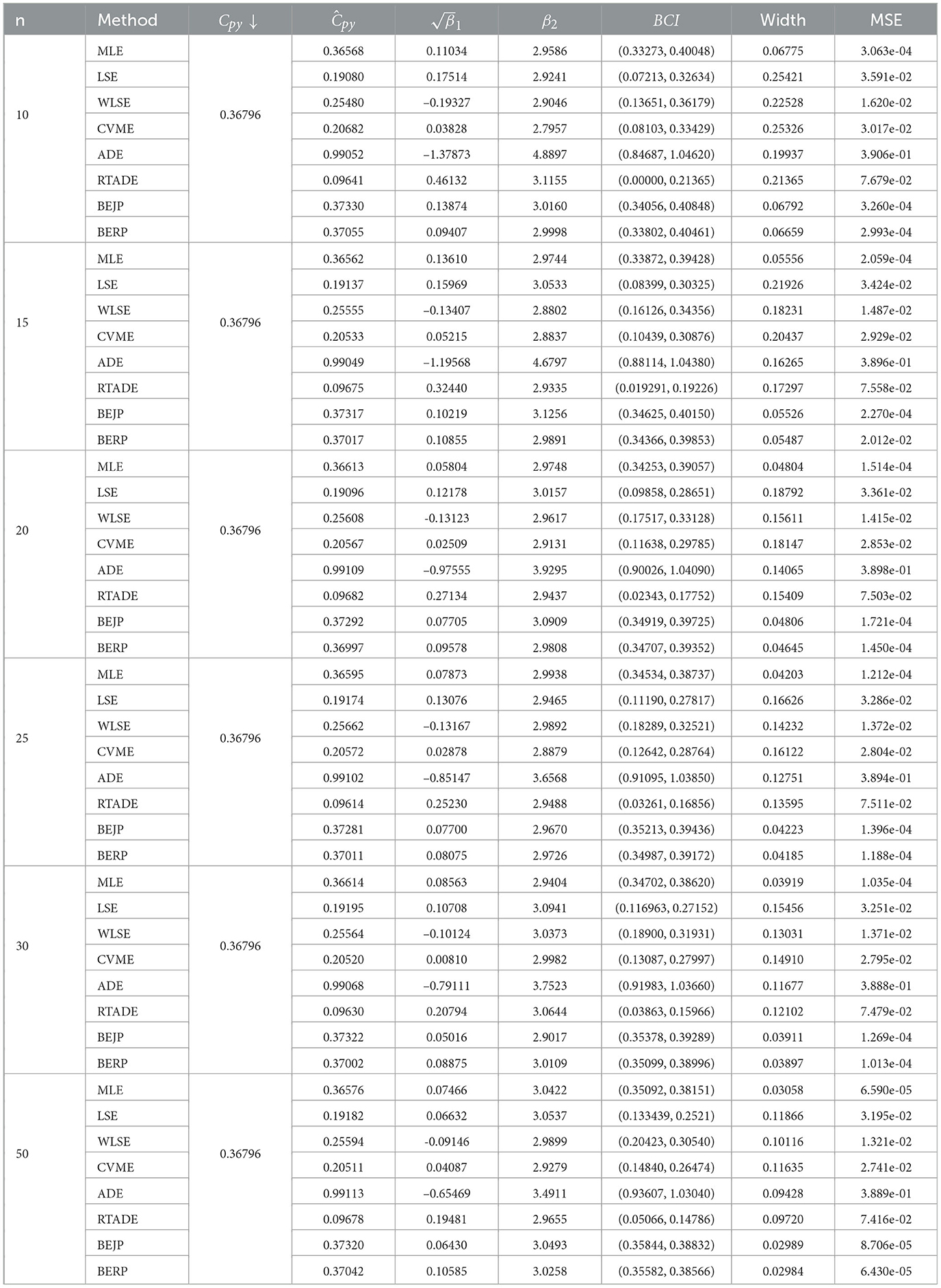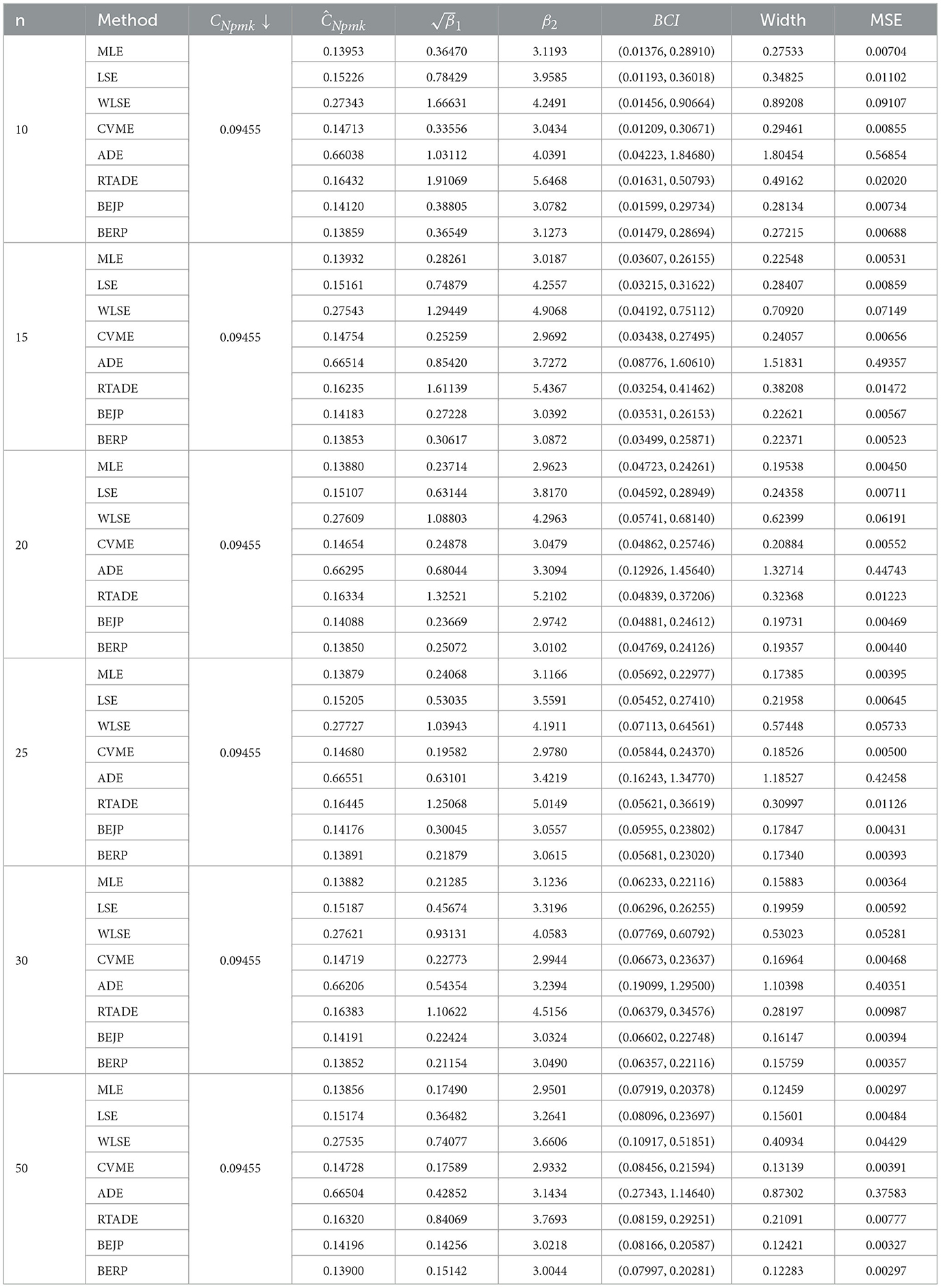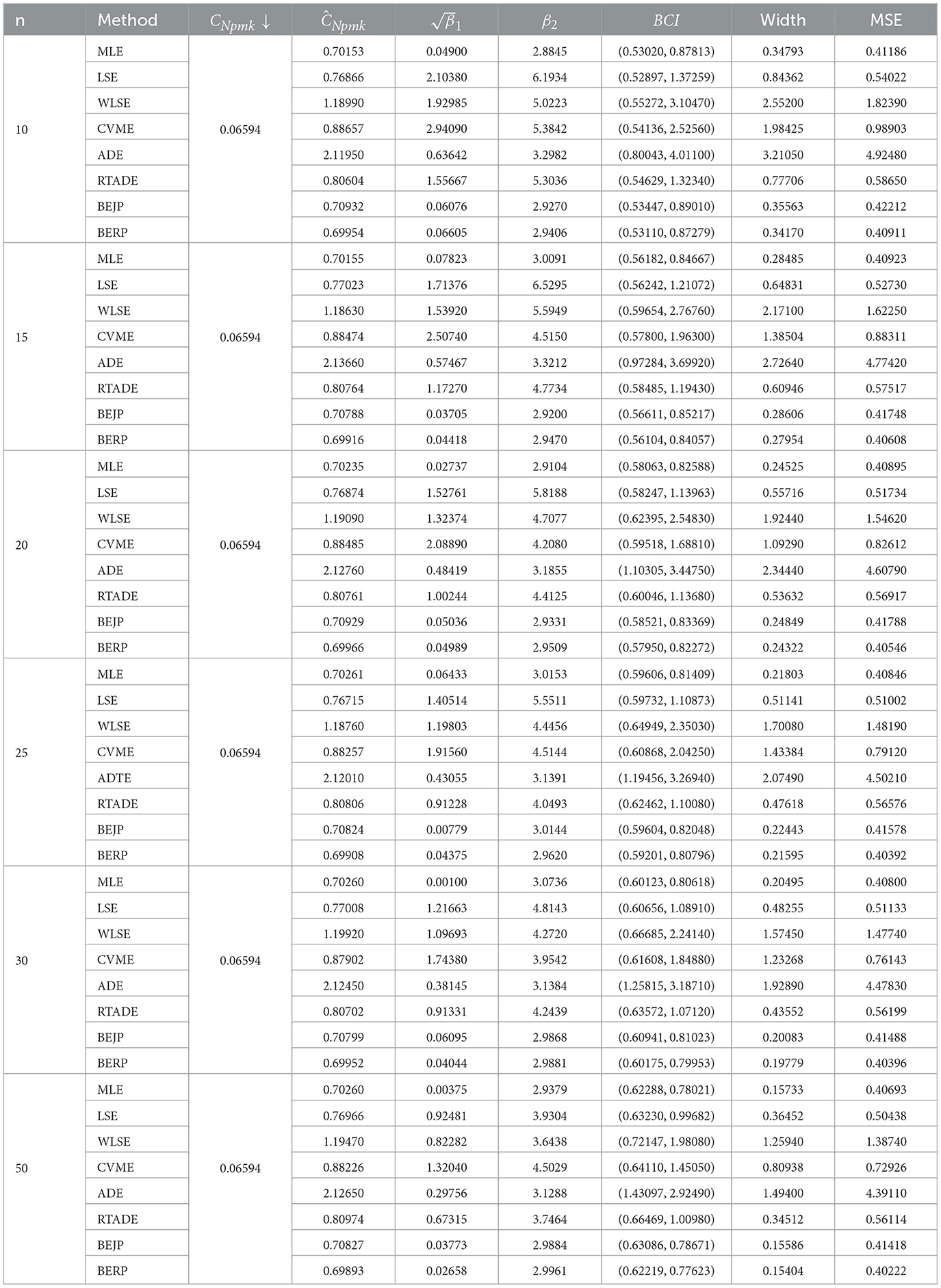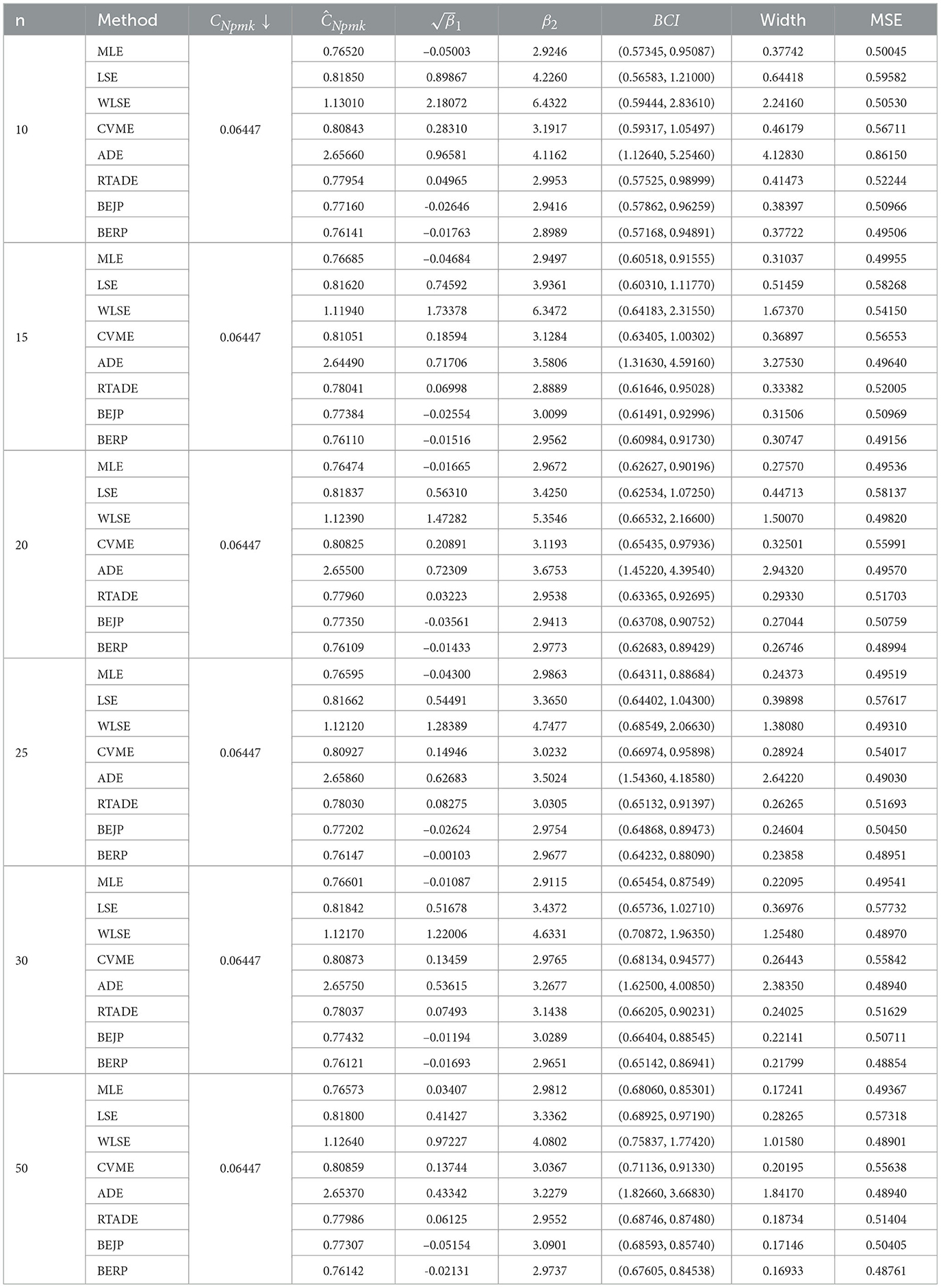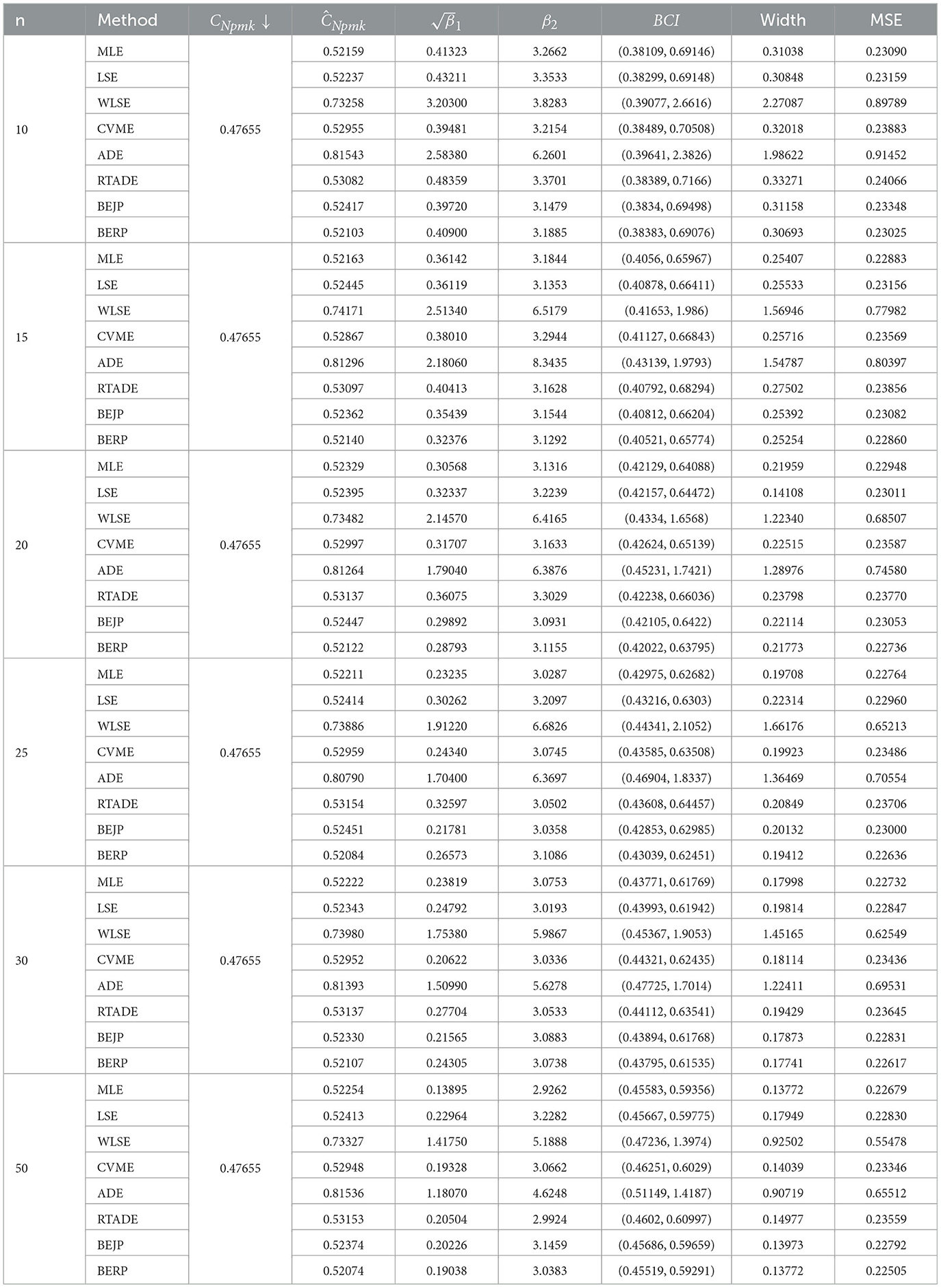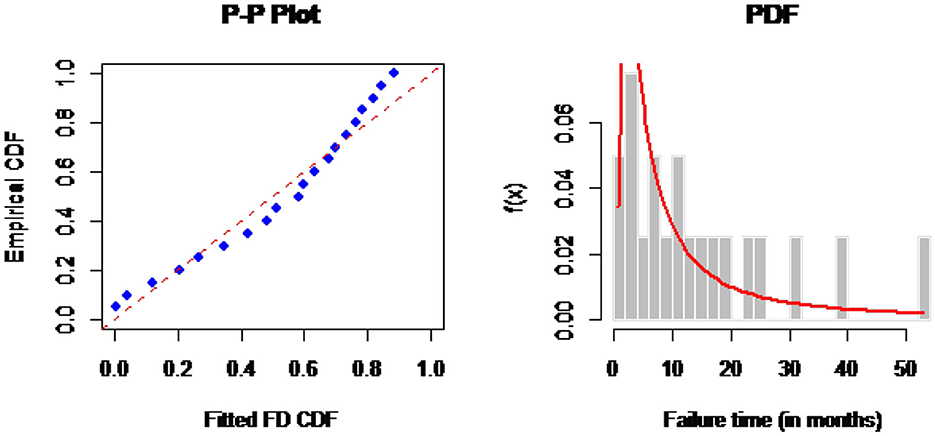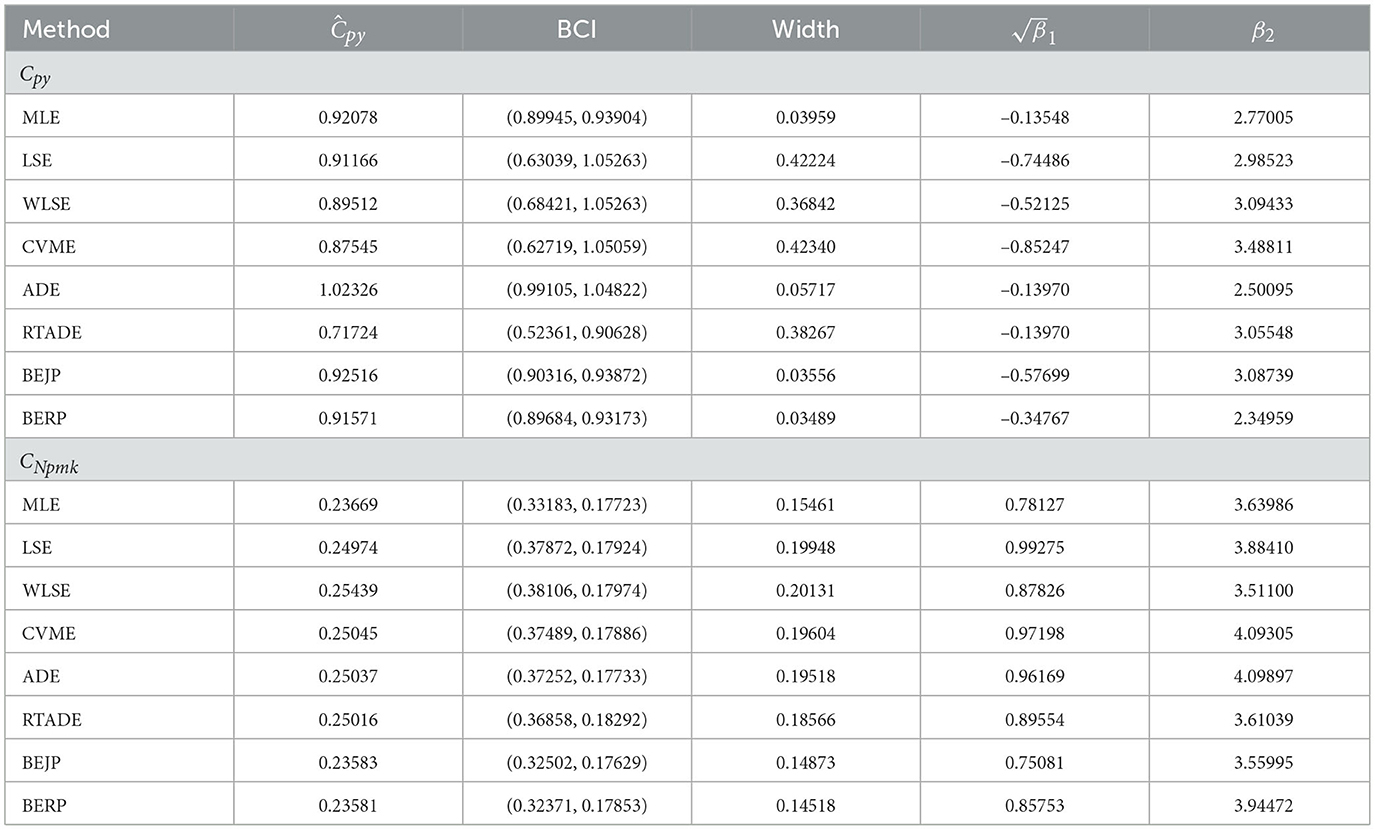- 1Department of Statistics, King Abdullah Campus Chatter Kalas, The University of Azad Jammu and Kashmir, Muzaffarabad, Pakistan
- 2Via Cesare Battisti, University of Padova, Padova, PD, Italy
- 3School of Interdisciplinary Engineering and Sciences (SINES), National University of Sciences and Technology (NUST), Islamabad, Pakistan
Process capability analysis is the statistical evaluation of process capability to examine how well it meets or exceeds the customers satisfaction. In present work, we are intended to evaluate two critical metrics for process quality assessment, Cpy and CNpmk for asymmetric Frechet distribution using different classical estimation methods namely: maximum likelihood, least squares, weighted least squares, Cramer-von-Mises, Anderson-Darling, right-tail Anderson-Darling, along Bayesian estimation using reference and Jeffreys priors. Furthermore, Monte Carlo simulations are conducted for comparative analysis of aforementioned estimation methods, using mean squared error and width of bootstrap confidence intervals. Comparative analysis demonstrates that Bayesian estimation using reference prior consistently producing smaller coefficient of mean squared errors and reduced width of bootstrap intervals for small to moderately large sample sizes. Moreover, the real data analysis is also validating the advantages of Bayesian estimations for process capability analysis.
1 Introduction
Statistical process control (SPC) is crucial for quality control in the highly competitive manufacturing industry. Process capability analysis is a vital component of SPC quality improvement programs. An essential part of SPC quality improvement initiatives is process capability analysis. Manufacturing process capabilities can be evaluated quantitatively and intuitively with the help of process capability indices (PCIs). These indices help identify areas for improvement and show how well a process meets customer needs. Over capability analysis, a process is evaluated using statistical methods to see whether it fulfills a set of customers preset specifications or not. Suppliers and manufacturers employ such measures to ensure that their finished products are of excellent quality and have the least amount of discrepancies. Capability indices are the most commonly used techniques for capability analysis. A PCI quantifies how well the process meets customer expectations.
Several PCIs have been suggested to quantify process performance. The readers may refer to Kane [1], addressed two often used indices: Cp and Cpk, Chan et al. [2] and Pearn et al. [3] devised two more advanced indices: Cpm and Cpmk. Choi and Owen [4] provided thorough comparisons of Cp, Cpk, Cpm, and Cpmk. Boyles [5] introduced PCI with asymmetric tolerance for Cpk, Cpm, and Cpmk. Many statisticians and quality researchers, including Kane [1], Chan et al. [2], Chou et al. [6], Pearn et al. [3], and Pearn and Chen [7], have discussed and analyzed point estimation and interval estimation of various indices.
The efficacy of these indicators is dependent on the process following a normal distribution [8–10]. However, the presence of various noise elements might occasionally result in abnormal manufacturing processes [11]. If the assumption is not met, these basic indices are not reliable [12–16]. For non-normal processes, the normality-based classical PCI may produce unreliable and misleading interpretations [17]. Pearn and Chen [18], Tong and Chen [19], and Senvar and Kahraman [17] all studied non-normal distributions. Still, we were unable to depend on one method that functions efficiently in all situations [11]. Furthermore, for various non-normal distributions, it is also claimed that each method performed differently [10]. Thus, for statisticians and practitioners, evaluating various PCIs under non-normal distributions is a crucial research topic. The widespread usage of PCIs in manufacturing requires a thorough analysis of proposed structures of PCIs in the literature using different estimating techniques and distributions.A PCI evaluates the amount of variation process experiences in relation to specification limitations. Point and interval estimations are often emphasized while analyzing PCIs. However, there is a possibility that point estimate will not conclude a realistic assessment of a process' capabilities and confidence intervals (CIs) are considered more useful in determining the variability of an estimate [20]. Hsiang and Taguchi [21] initiated the first move toward constructing CIs for the PCI. Since then, various methods for constructing CIs have been developed. One of these methods is bootstraping, which is unconstrained by distributional assumptions and makes complex inferences in simplified manners. In reality, insufficient or limited data is evaluated using a basic re-sampling method owing to time and budgetary restrictions. Franklin and Wasserman [22] initially used the bootstrap approach to evaluate the PCI-Cpk. Recently, significant advances have been made in the literature about bootstrap CIs and how they behave for processes in absence of normality assumption. Some studies in this regard include Kashif et al. [23], Rao et al. [24, 25], Peng [26], Dey and Saha [27, 28], Dey et al., [29], Saha et al. [30, 31], and Weber et al. [32].
Most statistical studies rely on one of two estimating categories: Bayesian or frequentist. PCIs for both normal and non-normal processes were developed using Bayesian and classical perspectives. Several statisticians, including Chan et al. [2], Cheng and Spiring [33], and Shiau et al. [34, 35], have justified and emphasized the advantages of the Bayesian method. Ramos et al. [36] provided a brief comparison of conventional and Bayesian estimation methods.
In present work, we are intended to develop PCIs named Cpy and CNpmk for Frechet distribution (FD) utilizing different classical methods provided in Ramos et al. [36] listed as, maximum likelihood, least square, Cramer-von-Mises and Anderson-Darling. Additionally, we are using weighted least square, right-tail Anderson-Darling estimators and Bayesian estimators using reference prior along Jeffrey prior for evaluation of PCIs.
The FD is a special case of the generalized extreme value distribution, used to model the maximum of large numbers of independent positive random variables. FD is equivalent to the inverse exponential distribution for the scale parameter β = 1; it is the inverse gamma distribution when β < 1 and for β = 2; it is the inverse Rayleigh distribution. The FD may be utilized in reliability analysis, especially when examining the quality characteristic of fatigue lifespan (the marketing life expectancy of pharmaceutical, automobile radiators, textile fatigue, and electron tubes, among other devices and variables). It provides flexible models for non-normal and asymmetric quality characteristics. Most suited to right-skewed characteristics where small values are most likely but rare extreme values exist. The probability density function (PDF), cumulative distribution function (CDF) and quantile function (QF) are given by
Kanwal and Abbas [37] evaluated PCIs Spmk and Cs for FD. Kanwal and Abbas [38] provided comparative analysis of quantile based control charts for FD. It is important to note that while the quality characteristic X specifically follows FD, no effort has been taken to investigate PCIs particularly Cpy and CNpmk. The research aims to bridge the gap. Our objective is to provide recommendations for selecting the most effective PCI estimation technique. It is hoped this study will benefit quality engineers, management professionals, and statisticians. In continuation to the introductory section, the remainder of the article is structured as follows. Section 2 comprises of introduction to PCI Cpy and PCI CNpmk. In Section 3 sensitivity analysis is performed, Section 4 presents several classical estimation methods for Cpy and CNpmk whereas bootstrap confidence intervals (BCIs) are covered in Section 5. Section 6 includes a simulation study to evaluate the estimators' effectiveness in estimating Cpy and CNpmk in terms of mean squared error (MSE), coefficient of skewness (), coefficient of kurtosis (β2), and BCIs width. Section 7 analyzes the real-life data set as an illustration. Finally, the findings of the present study are shown in Section 8.
2 PCIs Cpy and CNpmk
The detail of PCIs Cpy and CNpmk is given below.
2.1 PCI Cpy
A generalized PCI Cpy has been proposed by Maiti et al. [39]. It includes continuous and discrete random variables, both normal and non-normal, and is either directly or indirectly associated with most PCIs in literature. It can be defined as:
where p is the process output, p0 is the desired output, LDL and UDL denotes the lower and upper desirable limits, and USL and LSL are upper and lower specifications respectively. Where, LDL = μ−3σ and UDL = μ+3σ. PCI Cpy may be expressed as (p/0.9973) for process following a normal distribution. The Cpy for FD quality characteristic can be expressed as
2.2 PCI CNpmk
Vannman [40] combined these four indices Cp, Cpk, Cpm and Cpmk into one super-structure, defined as
where d = (USL − LSL)/2 and m = (USL + LSL)/2. In particular, we have, Cp(0, 0) = Cp, Cp(1, 0) = Cpk, Cp(0, 1) = Cpm and Cp(1, 1) = Cpmk. These indices have been developed when underlying distribution is normal. Later, Chen and Pearn [16] generalized Vannman [40] work and developed a new quantile-based PCI index CNp (u, v) for any underlying distribution, defined as
where Fα is the α-th percentile, M is the median. Whereas, median M for is a more robust measure skewed distributions than the process mean μ. Setting (u, v)= (1, 1) leads to CNpmk, for any distribution, given as
where
and
where, γi − th are quantiles of the two parameter FD with parameters (α, β). The CNpmk for FD quality characteristic can be written as
3 Sensitivity analysis
For a given PCI, the net sensitivity (NS) analysis for distribution function is proposed by Maiti et al. [39], and is defined as
If the NS values are low (in absolute) with respect to the PCI, the distribution is less sensitive and more robust. However, if the NS values are positive, the considered distribution is more sensitive (or less robust) at USL than at LSL; if the NS values are negative, the converse is true. The unit of measurement for the NS values is defectives per million (dpm). The NS values for the following distributions are presented in Table 1. It is apparent from Table 1 that overall FD is more robust as compare to Weibul and log-logistic distribution and Figure 1 shows that Weibull, log-logistic and FD all are less sensitive (or more robust) at USL for the considered values of (L; U) = (1;4) and p0 = 0.95, respectively.
4 Different methods of estimation for Cpy and CNpmk
Here, we describe eight different estimators, namely, maximum likelihood estimator (MLE), ordinary least square estimator(LSE) and weighted least squares estimator (WLSE), Cramer-von-Mises estimator (CVME), Anderson-Darling estimator (ADE), and right tail Anderson-Darling estimator (RTADE), Bayesian estimator under reference prior (BERP), and Jeffrey prior (BEJP) to find out the estimates of the parameters α and β for FD and the corresponding estimators of Cpy and CNpmk respectively. The non-linear equations can be solved by using nleqslv package which is available in the R-software [41].
4.1 Maximum likelihood estimator
Let x1, x2, …, xn be a random sample of size n taken from Equation 1.1. Then the log-likelihood function is
The partial derivatives are
The solutions to these equations do not result in closed form for MLEs. However, these equations are solved simultaneously using a numerical approach. Substituting the MLEs in Equations 2.2, 2.3, we can get the estimators of Cpy and CNpmk as
4.1.1 Ordinary and weighted least squares estimator
Swain et al. [42] proposed a least squares approach to minimize the distance in Johnson's translation system. Suppose F(x(i:n)|α, β) denotes the CDF of ordered random variables x1 ≤ x2 ≤ ... ≤ xn of size n from a distribution function F(.|α, β). The least squares estimators of and can be obtained by minimizing the function
differentiating with respect to α and β. The estimators can be obtained by solving the following
where
and
Similarly, the weighted least squares estimator of and can be obtained by minimizing the function by Erto and Genesis [43].
WLSEs can be obtained by solving the following
Where ξ1(xi|α, β) and ξ2(xi|α, β) are shown in Equations 4.8, 4.9. The least squares and weighted least squares estimators of PCI-Cpy for FD are
Similarly, the least squares and weighted least squares estimators of PCI-CNpmk for FD are
4.1.2 Cramer-von-Mises estimator
The Cramer-von-Mises test was proposed by Cramer [44] and von-Mises [45], which measures the distance between empirical distribution function and CDF of assumed model. Moreover, Boos [46] studied its properties, which can be expressed as
The Cramer-von-Mises estimator of and can be incurred by solving the following
Where ξ1(xi|α, β) and ξ2(xi|α, β) are mentioned in Equations 4.8, 4.9. The corresponding estimators of PCIs-Cpy and CNpmk are
4.1.3 Anderson-Darling estimator
Anderson-Darling [47] statistic belong to the class of quadratic empirical distribution function [48]. The Anderson-Darling test (ADT) converges rapidly toward the asymptote [49], which is
The Anderson-Darling estimator (ADE), and can also be obtained by solving the following non-linear equations
The right tail Anderson-Darling estimator, and are obtained by minimizing with respect to α and β, the function
These estimators can also be obtained by solving the following non-linear equations
The ADE and RTADE of PCI Cpy for FD are
Similarly, the corresponding ADE and RTADE of PCI CNpmk for FD are
4.2 Bayesian estimator
This section considers the BERP and BEJP for estimation of unknown parameters of the FD. Abbas and Tang [50] derived Jeffrey's and reference priors for FD, which are as follows:
The joint posterior distributions using Jeffrey's and reference prior can be written as
The Bayesian estimators of model parameters employing squared error loss function are obtained using Laplace approximation. Which is accessible through the LearnBayes package [51]. The BERP and BEJP of PCI-Cpy are given as
Similarly, the corresponding BERP and BEJP of PCI CNpmk for FD are
5 BCIs for Cpy and CNpmk
Franklin and Wasserman [22] developed the bootstrap approach, which is typically employed to obtain the empirical distribution of different PCIs. We evaluated standard BCIs for Cpy and CNpmk. The basic steps for bootstrapping are as follows:
• A random sample (x1, x2, …, xn) of size n, is drawn from FD(α, β), followed by n bootstrap samples (with replacement) taken from the original sample with a mass of 1/n at each. Classical and Bayesian estimates of are obtained and then R-th bootstrap estimator are calculated for Cpy & CNpmk, i.e.,
• A total of nn re-samples exist, and for each sample, is obtained, resulting in a full bootstrapped distribution and is denoted by , and same process is done for .
6 Simulation study
The present section deals with the simulation experiment for performance assessments of the PCIs namely Cpy and CNpmk for FD based on aforementioned estimation methods. Different parametric combinations (α, β) = [(1, 3.5)(1, 2)(1, 4)(1.2, 2.2)] for Cpy and (1, 2.5), (2.1, 1.6), [1.6, 2.1, (1.6,1.7)] for CNpmk against sample size n = 10, 15, 20, 25, 30, 50 are evaluated and the LSL and USL are set as 1 and 4, respectively whereas, target value is 2.5 and p0 = 0.95. For each design, 95% BCIs were evaluated, along the difference of both the upper and lower confidence bounds, referred as the average width, (), (β2), and MSE, to compare the results shown in Tables 2–5 for PCI Cpy and Tables 6–9 for PCI CNpmk with 10,000 replications using the R-software. Results are evaluated based on indices with reduced average width and minimum MSE.
The results presented in Tables 2–9, all demonstrate that with increase in sample size, both average width and MSE are reduced for all PCIs against all estimation methods, suggesting that a small sample size, n < 25 and moderately large (30, 50) sample produces better results.
If we look more closely, we can find that the BERP has minimum MSEs for small to moderate sample sizes when compared to MLE, LSE, WLSE, CVME, ADE, RTADE, and BEJP. Moreover, the MSE are least for BERP for both PCIs Cpy and CNpmk. Furthermore, in this investigation BERP outperformed other estimating methods by producing the least width of estimates for the configurations under consideration.
7 Real data illustration
This section examines the actual dataset comprising of the failure timings of 20 electric carts, as presented by Rao et al. [24], listed in Table 10. To evaluate the BCIs of PCIs the estimation methods ML, LS, WLS, CVM, AD, RTAD, BEJP, and BERP are utilized. Initially, we evaluate if the analyzed data set originates from a FD by examining the p-value of the Kolmogorov-Smirnov (KS) test, Anderson-Darling (AD) and Cramer-von Mises (CVM) test. The point estimates for the data set are α = 0.9070176, β = 5.2836813. The statistic along with p-values of corresponding goodness of fit test are summarized in Table 11 and complemented the analysis with graphical diagnostics, density and PP plots in Figure 2. Which are evident that this data set follows two parameter FD quite well. To estimate the PCIs, the USL and LSL, were set to 53.0 and 0.90 respectively and p0 = 0.95. The mean of the data set, T = 26.95, is set as the target value. Table 12 shows the BCI widths of the PCIs Cpy and CNpmk based on the aforementioned estimation techniques for FD. It is clear from Table 12 that BERP has a narrow BCI than its counterparts. BERP is a more effective method for employing PCI interval estimations. For all PCIs, BERP outperformed MLE and BEJP and all aforementioned methods in terms of BCI width. The distribution shape of PCIs is approximately normal. This study suggests that BERP is more effective for examining observed PCIs.
8 Conclusion
This article examines two PCIs: Cpy and CNpmk, using various estimating approaches for FD. In general, we used the MLE, LSE, WLSE, CVME, ADE, RTADE, BERP, and BEJP to produce estimates and BCIs for the aforementioned PCIs. Extensive simulation studies were conducted to compare these approaches with various small to moderately large sample sizes and parametric values. The average estimates for these PCIs, along with their coefficient of skewness, kurtosis, BCIs, and corresponding MSEs, have been acquired. The MSE of CNpmk is significantly less than that of Cpy. Furthermore, simulation findings indicated that BERP outperformed the other estimators for MSEs and the width of PCIs. The examination of the real data set validated this finding. This study aims to help engineering professionals and applied statisticians.
Data availability statement
The original contributions presented in the study are included in the article/supplementary material, further inquiries can be directed to the corresponding author.
Author contributions
TK: Formal analysis, Methodology, Software, Writing – original draft, Conceptualization. KA: Project administration, Supervision, Software, Writing – review & editing. MZ: Resources, Writing – review & editing. ZH: Writing – review & editing, Resources, Methodology.
Funding
The author(s) declare that no financial support was received for the research and/or publication of this article.
Conflict of interest
The authors declare that the research was conducted in the absence of any commercial or financial relationships that could be construed as a potential conflict of interest.
Generative AI statement
The author(s) declare that no Gen AI was used in the creation of this manuscript.
Any alternative text (alt text) provided alongside figures in this article has been generated by Frontiers with the support of artificial intelligence and reasonable efforts have been made to ensure accuracy, including review by the authors wherever possible. If you identify any issues, please contact us.
Publisher's note
All claims expressed in this article are solely those of the authors and do not necessarily represent those of their affiliated organizations, or those of the publisher, the editors and the reviewers. Any product that may be evaluated in this article, or claim that may be made by its manufacturer, is not guaranteed or endorsed by the publisher.
References
1. Kane VE. Process capability indices. J Quality Technol. (1986) 18:41–52. doi: 10.1080/00224065.1986.11978984
2. Chan LK, Cheng SW, Spiring FA. A new measure of process capability: CPM. J Quality Technol. (1988) 20:162–75. doi: 10.1080/00224065.1988.11979102
3. Pearn WL, Kotz S, Johnson NL. Distributional and inferential properties of process capability indices. J Quality Technol. (1992) 24:216–31. doi: 10.1080/00224065.1992.11979403
4. Choi BC, Owen DB. A study of a new process capably index. Commun Stat Theory Methods. (1990) 19:1231–45. doi: 10.1080/03610929008830258
5. Boyles RA. Process capability with asymmetric tolerances. Commun Stat Simul Comput. (1994) 23:615–35. doi: 10.1080/03610919408813190
6. Chou YM, Owen DB, Salvador A, Borrego A. Lower confidence limits on process capability indices. J Quality Technol. (1990) 22:223–9. doi: 10.1080/00224065.1990.11979242
7. Pearn WL, Chen KS, A. Bayesian-like estimator of CPK. Commun Stat Simul Comput. (1996) 25:321–9. doi: 10.1080/03610919608813316
8. Kashif M, Aslam M, Al-Marshadi AH, Jun CH. Capability indices for non-normal distribution using Ginis mean difference as measure of variability. IEEE Access. (2016) 4:7322–30. doi: 10.1109/ACCESS.2016.2620241
9. Panichkitkosolkul W. Confidence intervals for the process capability index CP based on confidence intervals for variance under non-normality. Malays J Mathem Sci. (2016) 10:101–15.
10. Senvar O, Sennaroglu B. Comparing performances of clements, box-cox, Johnson methods with weibull distributions for assessing process capability. J Ind Eng Manag. (2016) 9:634–56. doi: 10.3926/jiem.1703
11. Piña-Monarrez MR, Ortiz-Yañez JF, Rodríguez-Borbón MI. Non-normal capability indices for the Weibull and lognormal distributions. Quality Reliab Eng Int. (2016) 32:1321–9. doi: 10.1002/qre.1832
12. Chan LK, Cheng SW, Spiring FA. The Robustness of the Process Capability Index CP to Departures From Normality. North Holland, Amsterdam: Statistical Theory and Data Analysis II (1988). p. 223–39.
14. English JR, Taylor GD. Process capability analysis - a robustness study. Int J Prod Res. (1993) 31:1621–35. doi: 10.1080/00207549308956813
15. Somerville SE, Montgomery DC. Process capability indices and non-normal distributions. Qual Eng. (1996) 9:305–16. doi: 10.1080/08982119608919047
16. Chen KS, Pearn WL. An application of non-normal process capability indices. Quality Reliab Eng Int. (1997) 13:355–60. doi: 10.1002/(SICI)1099-1638(199711/12)13:6<355::AID-QRE125>3.0.CO;2-V
17. Senvar O, Kahraman C. Type-2 fuzzy process capability indices for non-normal processes. J Intell Fuzzy Syst. (2014) 27:769–81. doi: 10.3233/IFS-131035
18. Pearn WL, Chen KS. Estimating process capability indices for non-normal pearsonian populations. Quality Reliab Eng Int. (1995) 11:386–8. doi: 10.1002/qre.4680110510
19. Tong LI, Chen JP. Lower confidence limits of process capability indices for non-normal process distributions. Int J Quality Reliab Manag. (1998) 15:907–19. doi: 10.1108/02656719810199006
20. Smithson M. Correct confidence intervals for various regression effect sizes and parameters: the importance of noncentral distributions in computing intervals. Educ Psychol Meas. (2001) 61:605–32. doi: 10.1177/00131640121971392
21. Hsiang TC, A. tutorial on quality control and assurance-the Taguchi methods. In: ASA Annual Meeting LA. (1985).
22. Franklin LA, Gary W. Bootstrap confidence interval estimates of CPK: an introduction. Commun Stat Simul Comput. (1991) 20:231–42. doi: 10.1080/03610919108812950
23. Kashif M, Aslam M, Rao GS, AL-Marshadi AH, Jun CH. Bootstrap confidence intervals of the modified process capability index for Weibull distribution. Arabian J Sci Eng. (2017) 42:4565–73. doi: 10.1007/s13369-017-2562-7
24. Rao GS, Aslam M, Kantam RR. Bootstrap confidence intervals of C NPK for inverse Rayleigh and log-logistic distributions. J Stat Comput Simul. (2016) 86:862–73. doi: 10.1080/00949655.2015.1040799
25. Rao GS, Albassam M, Aslam M. Evaluation of bootstrap confidence intervals using a new non-normal process capability index. Symmetry. (2019) 11:484–92. doi: 10.3390/sym11040484
26. Peng C. Parametric lower confidence limits of quantile-based process capability indices. Quality Technol Quant Manag. (2010) 7:199–214. doi: 10.1080/16843703.2010.11673228
27. Dey S, Saha M, Maiti SS, Jun CH. Bootstrap confidence intervals of generalized process capability index CPYK for Lindley and power Lindley distributions. Commun Stat Simul Comput. (2018) 47:249–62. doi: 10.1080/03610918.2017.1280166
28. Dey S, Saha M. Bootstrap confidence intervals of generalized process capability index C PYK using different methods of estimation. J Appl Stat. (2019) 46:1843–69. doi: 10.1080/02664763.2019.1572721
29. Dey S, Saha M. Bootstrap confidence intervals of process capability index S PMK using different methods of estimation. J Stat Comput Simul. (2020) 90:28–50. doi: 10.1080/00949655.2019.1671980
30. Saha M, Dey S, Maiti SS. Parametric and non-parametric bootstrap confidence intervals of C NPK for exponential power distribution. J Ind Prod Eng. (2018) 35:160–9. doi: 10.1080/21681015.2018.1437793
31. Saha M, Dey S, Maiti SS. Bootstrap confidence intervals of C pTk for two parameter logistic exponential distribution with applications. Int J Syst Assur Eng Manag. (2019) 10:623–31. doi: 10.1007/s13198-019-00789-7
32. Weber S, Ressurreição T, Duarte C. Yield prediction with a new generalized process capability index applicable to non-normal data. IEEE Trans Comput-Aided Des Integr Circ Syst. (2015) 35:931–42. doi: 10.1109/TCAD.2015.2481865
33. Cheng SW, Spiring FA. Assessing process capability: a Bayesian approach. IIE Trans. (1989) 21:97–8. doi: 10.1080/07408178908966212
34. Shiau JJ, Chiang CT, Hung HN. A Bayesian procedure for process capability assessment. Quality Reliab Eng Int. (1999) 15:369–78. doi: 10.1002/(SICI)1099-1638(199909/10)15:5<369::AID-QRE262>3.0.CO;2-R
35. Shiau JJ, Hung HN, Chiang CT. A note on Bayesian estimation of process capability indices. Stat Probab Lett. (1999) 45:215–24. doi: 10.1016/S0167-7152(99)00061-9
36. Ramos PL, Louzada F, Ramos E, Dey S. The Frechet distribution: estimation and application-an overview. J Stat Manag Syst. (2020) 23:549–78. doi: 10.1080/09720510.2019.1645400
37. Kanwal T, Abbas K. Bootstrap confidence intervals of process capability indices SPMK, SPMKC and CS for Frechet distribution. Quality Reliab Eng Int. (2023) 39:2244–57. doi: 10.1002/qre.3333
38. Kanwal T, Abbas K. Comparative analysis of quantile-based control charts for Frechet distribution. Qual Eng. (2025) 2025:1–16. doi: 10.1080/08982112.2025.2543006
39. Maiti SS, Saha M, Nanda AK. On generalizing process capability indices. Quality Technol Quant Manag. (2010) 7:279–300. doi: 10.1080/16843703.2010.11673233
41. Dennis Jr JE, Schnabel RB. Numerical Methods for Unconstrained Optimization and Nonlinear Equations. Society for Industrial and Applied Mathematics. (1996). doi: 10.1137/1.9781611971200
42. Swain JJ, Venkatraman S, Wilson JR. Least-squares estimation of distribution functions in Johnson's translation system. J Stat Comput Simul. (1988) 29:271–97. doi: 10.1080/00949658808811068
43. Erto P. Genesis properties and identification of the inverse Weibull lifetime model. Statistica Appl. (1989) 1:117–28.
44. Cramer H. On the composition of elementary errors: First paper: mathematical deductions. Scand Actuar J. (1928) 1928:13–74. doi: 10.1080/03461238.1928.10416862
46. Boos DD. Minimum distance estimators for location and goodness of fit. J Am Stat Assoc. (1981) 76:663–70. doi: 10.1080/01621459.1981.10477701
47. Anderson TW, Darling DA. Asymptotic theory of certain" goodness of fit" criteria based on stochastic processes. Ann Mathem Stat. (1952) 1:193–212. doi: 10.1214/aoms/1177729437
48. Stephens MA. EDF statistics for goodness of fit and some comparisons. J Am Stat Assoc. (1974) 69:730–7. doi: 10.1080/01621459.1974.10480196
49. Pettitt AN. A two-sample Anderson-Darling rank statistic. Biometrika. (1976) 63:161–8. doi: 10.1093/biomet/63.1.161
50. Abbas K, Tang Y. Analysis of Frechet distribution using reference priors. Commun Stat Theory Methods. (2015) 44:2945–56. doi: 10.1080/03610926.2013.802351
Keywords: process capability indices, Bayesian estimators, classical estimators, bootstrap confidence intervals, mean squared errors
Citation: Kanwal T, Abbas K, Zaman M and Hussain Z (2025) Bootstrap confidence intervals of process capability indices Cpy and CNpmk using different methods of estimation for Frechet distribution. Front. Appl. Math. Stat. 11:1668809. doi: 10.3389/fams.2025.1668809
Received: 18 July 2025; Accepted: 22 September 2025;
Published: 14 October 2025.
Edited by:
Stelios Psarakis, Athens University of Economics and Business, GreeceReviewed by:
Zakariya Yahya Algamal, University of Mosul, IraqMahendra Saha, University of Delhi, India
Copyright © 2025 Kanwal, Abbas, Zaman and Hussain. This is an open-access article distributed under the terms of the Creative Commons Attribution License (CC BY). The use, distribution or reproduction in other forums is permitted, provided the original author(s) and the copyright owner(s) are credited and that the original publication in this journal is cited, in accordance with accepted academic practice. No use, distribution or reproduction is permitted which does not comply with these terms.
*Correspondence: Mehwish Zaman, bWVod2lzaC56YW1hbkBzdHVkZW50aS51bmlwZC5pdA==
 Tahira Kanwal
Tahira Kanwal Kamran Abbas
Kamran Abbas Mehwish Zaman
Mehwish Zaman Zamir Hussain
Zamir Hussain
